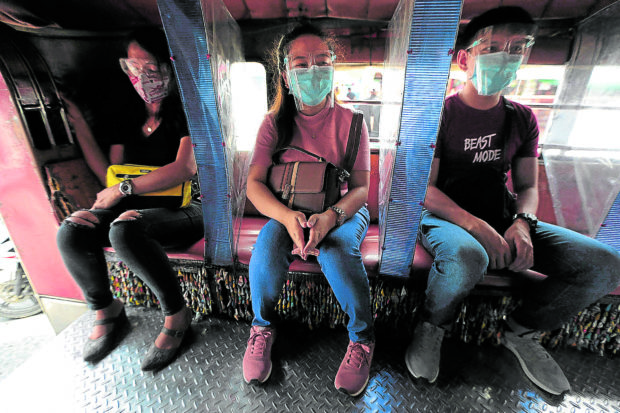Gov’t reduces physical distancing on PUVs

DISTANCE BETWEEN US The move by transportation officials to reduce the 1-meter rule for physical distancing on public vehicles has raised fears of more coronavirus infections and deaths. —GRIG C. MONTEGRANDE
MANILA, Philippines — The government will reduce physical distancing on public vehicles on Monday as commuter safety advocates and the Vice President questioned the basis for the decision, which they say could lead to a worse surge in coronavirus infections.
On Saturday, the Department of Transportation (DOTr) announced that it would proceed with its plan to gradually reduce the 1-meter rule, starting with 0.75 meters on Monday to help the public transport sector recover from a slump forced by coronavirus lockdowns since March, and to stimulate growth of the economy, which slipped into recession in the second quarter.
More jeepney routes
At the same time, the Land Transportation Franchising and Regulatory Board (LTFRB), an agency overseen by the DOTr, said it would reopen 28 more jeepney routes in Quezon City, Manila, Makati and Muntinlupa, adding 1,159 more jeeps to public transport, starting Monday.
According to the DOTr plan, physical distancing on public vehicles further shrinks to 0.5 meters on Sept. 28, then to 0.3 meters on Oct. 12.
The Department of Health (DOH) objected to the plan, insisting on the 1-meter distance recommended by the World Health Organization (WHO).
Article continues after this advertisementOn Sunday, the DOH reported 3,372 additional infections, bringing the national tally to 261,216 cases. It said 79 more patients had died, raising the death toll to 4,371, and 20,472 more patients had recovered, pushing the total number of COVID-19 survivors to 207,568, and leaving the country with 49,277 active cases.
Article continues after this advertisement7th mass-recovery report
The large number of new recoveries was the result of the DOH’s new strategy of counting mild and asymptomatic cases as recovered after 14 days of isolation.
It was the department’s seventh mass-recovery report since the shift took effect on July 13, when it reported 4,325 recoveries.
In a statement on Saturday, the commuter safety coalition Move as One warned that disregarding the health standards set by the DOH could result in more new coronavirus infections and deaths, “squandering the sacrifices [our health workers] and the gains achieved from the two-week timeout”—referring to the two-week return to strict lockdown requested by the medical community in August to tamp down a rise in infections and give hospital staff a respite.
“The medical experts in our group find no evidence [that] reducing physical distancing to less than 1 meter, even when combined with complementary measures, will provide sufficient protection to the riding public,” the group said.
Allow more jeepneys
It proposed that the DOTr instead allow more open public vehicles, such as jeepneys, to return to the road and give commuters better ventilation during their trips.
The LTFRB plan would bring to 17,000 the number of jeepneys operating in Metro Manila, but the coalition said this number was only a third of the total number of jeepneys that plied major routes in the metropolis before the pandemic.
The coalition also recommended that the government implement service contracting to boost public transport capacity.
Under that plan, the government hires public vehicles to ferry commuters on a fixed trip/per kilometer rate regardless of passenger load.
But a nighttime curfew in Metro Manila works against the reopening plan, as the absence of public transport at night prevents businesses with nighttime operations from reopening.
On her radio program on Sunday, Vice President Leni Robredo urged transport officials not to “gamble on things like public health” and to make decisions “based on science.”
“Is the 0.3-meter rule based on science?” Robredo asked. “If the point is to help drivers earn more, then that’s fine. But I think there are better ways to do this.”
Robredo recommended service contracting, which gets rid of the boundary system that eats up much of jeepney and bus drivers’ daily earnings.
“Let’s see what will happen in the next few weeks. But we’re praying that the [new distancing plan will] be effective,” she said.
‘Carefully calibrated’
Malacañang defended the DOTr plan, saying it was “carefully calibrated.”
Cabinet Secretary Karlo Nograles gave assurance on Saturday night that the plan would be implemented with other health measures—wearing masks and face shields, and hand sanitizing—to ensure that it would not lead to increased virus transmission.
Nograles, cochair of the Inter-Agency Task Force for the Management of Emerging Infectious Diseases, the temporary government body overseeing the administration’s coronavirus response, said easing public transport restrictions was part of a plan balancing public heath and the economy.
“These adjustments being done by the DOTr are carefully calibrated. But it doesn’t mean that if we reduce physical distancing, we won’t have more health protocols,” Nograles said.
He noted that other countries, including Japan, have begun easing public transport restrictions.
“In Japan they allow it,” Nograles said. “The DOTr is checking how many passengers [Japan’s trains are allowed to carry]. What do they use? Face masks and face shields. So it means we can slowly reduce physical distancing as long as [we] have additional health protocols.”
He said the task force would meet with health experts on Monday and discuss the matter during its meeting on Tuesday.
The head of the economic affairs committee of the House of Representatives on Sunday supported the DOTr plan, saying it would help get the economy back on its feet.
“Without public transport, people can’t go to work and businesses won’t open,” AAMBIS-OWA Rep. Sharon Garin said.
“When supply for public transportation is less than demand, people forgo social distancing. The wheels of the economy won’t start turning without ample public transportation,” she said.
—With reports from Krixia Subingsubing, Tina G. Santos, Julie M. Aurelio and DJ Yap